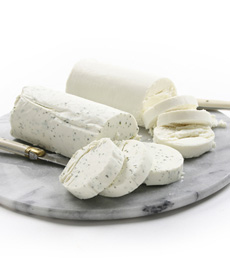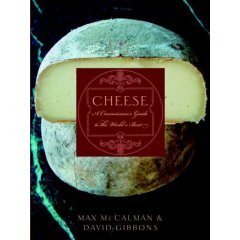
 Goat cheese was the first cheese to come to the New World, since goats were carried aboard ships as a source of fresh milk. Photo courtesy iGourmet.com.
September 2005
Last Updated June 2018
|
 |
The Origin Of Cheese
Page 4: The Middle Ages To The New World
This is Page 4 of four-page article on the history of cheese. Click on the black links below to visit other pages.
The Middle Ages and The Renaissance
From the decline of the Roman Empire until the discovery of America, monks in monasteries were the innovators in cheesemaking. In the Middle Ages they developed many of the classic varieties of cheese marketed today.
During the Renaissance (the European Renaissance spanned the 14th–16th centuries), cheese was considered unhealthy and suffered a decline in popularity. It regained favor by the nineteenth century, the period that saw the start of the move from farm to factory production.
Cheese Comes to the New World
Goat cheese was perhaps the first to make their way to new world. Goats were carried aboard ships as a sure source of fresh milk. They were on the Nina, the Pinta, and the Santa Maria as Christopher Columbus sailed to the New World in 1492.
When the Pilgrims voyaged to America in 1620, the Mayflower was stocked with cheese. The art of cheesemaking quickly spread in the New World, but until the 19th century it remained a local farm industry. It wasn’t until 1851 that the first cheese factory in the United States was built, by Jesse Williams in Oneida County New York.
The biggest cheese event occurred in 1801, when an enterprising cheesemaker delivered a mammoth 1,235-pound wheel of cheese to President Thomas Jefferson. Washingtonians dubbed it the “big cheese,” coining a phrase which has come to describe someone of importance.
As the population of the country grew, so did the demand for cheese. The industry gradually moved westward and settled on the rich farmlands of Wisconsin. In 1845 a group of Swiss immigrants settled in Green County, Wisconsin and started the manufacturer of “foreign” cheese. The first factory was a Limburger plant, which opened in 1868. By 1880 there were 3,923 dairy factories nationwide, which reported to have made 216 million pounds of cheese that year valued at $17 million. The 1904 census, reporting only factory output, totaled over 317 million pounds, which grew to 418 million pounds in 1920...and to 2.2 billion pounds by 1970.
Cheese Today
Rising demand for cheese throughout the 1970s and 1980s brought total natural cheese production to more than 6 billion pounds by the beginning of the 1990s. Processed cheese also experienced a surge in consumer demand with annual production exceeding 2 billion pounds a year by the beginning of the 1990s.
Currently, more than one-third of all milk produced each year in the U.S. is used to manufacture cheese. The industry continues to grow due to consumer appetites for all types of cheese—and pizza. Fine farmstead and artisanal cheeses are a fraction of a percent of the industry, but this sector, too, has been growing due to an increasingly sophisticated palate and demand for more and better cheese.
The average American eats more than 31 pounds of cheese per year. Mozzarella is the most frequently-consumed cheese (think pizza) at 9.64 pounds per capita, followed by cheddar, long favorite eating and snacking cheese, at 9.39 pounds per capita. In supermarkets, processed American cheeses (580 million pounds), Cheddar (530 million pounds), and Mozzarella (250 million pounds) are the three big sellers. Americans have been branching out into specialty and artisan cheeses, averaging 4.3% of the volume in 2003, led by Asiago and Gorgonzola at about 50% growth, with Havarti up nearly 40%.
With about 300 different varieties of cheese available in the U.S., 31 pounds per capita and deducting 9.6 for Mozzarella, it doesn’t seem like we’re eating nearly enough cheese!
Content from the International Dairy Foods Association and The Cheese Book by Richard Widcome, Chartwell Books, 1978.
Books About Cheese
 |
 |
 |
| Cheese, by Max McCalman. This long awaited book is a welcome addition to any cheese lovers library. Click here for more information. |
The Cheese Plate, by Max McCalman. Artisanal's top cheese shares his love and appreciation of cheese. Click here for information. |
Totally Cheese Cookbook, by Helene Siege. Easy to follow recipes that are all about cheese. Click here for information. |
Go To The Article Index Above

|







